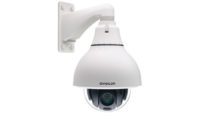As the industry continues to shift from standard definition to HD and megapixel video, “digital zoom” has become a major selling point. With a high-definition camera, you can continue to record an entire scene while zooming in digitally to examine a specific object or area more closely.
With that in mind, there may be some in the industry who are wondering whether there’s still a place for pan tilt zoom (PTZ) cameras in security installations. Based on research and conversations with several dealers and integrators, that seems to be true, and there are a lot of reasons for that beyond digital zoom.
Technological advancements have combined to improve the performance of these cameras, while also contributing to a reduction in price. In fact, there are a few PTZs out there that incorporate HD and megapixel technology.
So while there is a place for both fixed high-definition and PTZ cameras in the industry, a number of perceptions about PTZs exist within the marketplace. Some are true, some are outdated, and some are misperceptions. It is time to address a few of the misperceptions.
“The industry is no longer just analog, and truths are no longer truths,” says Kent Fransson, PTZ product manager for Axis Communications in Chelmsford, Mass.
Video Analytics
The reason behind PTZ cameras’ success is their ability to pan, tilt and zoom. In other words, it’s all in the motion. However, that very motion can make using video analytics with a PTZ camera difficult. Difficult, but not impossible.
“Video analytics generally do not perform well when a camera is in motion. The detection capabilities will be hampered, causing false detection, which defeats the purpose,” says Henry Kim, senior product manager for Samsung Techwin America, based in Carson, Calif. “However, video analytics can be effectively deployed using PTZ cameras when programmed for automated tours with the analytics applied when the cameras are stationary.”
The problem occurs most often in situations where a PTZ camera may not have been the best choice for a particular application or location, says Edward Hamilton, global product manager for Farmington, Conn.-based UTC Fire and Security.
“Analytics can run when the camera is in its home position, but with the calculations involved when a camera is in motion, it’s hard to do,” he says. “If you’re trying to use a PTZ in a situation where advanced analytics are necessary, I don’t know if I would have chosen a PTZ for that application.”
Some applications where video analytics can be successfully deployed with PTZ cameras include detection of abandoned or moved objects, perimeter protection, and any entry or exit point.
Greg Bier, CEO of Vitek, based in Valencia, Calif., advocates using PTZ cameras in conjunction with another type of camera that’s designed for use with video analytics.
“PTZs are best used in conjunction with fixed cameras using analytics. When a condition or event occurs, the PTZ is programmed to pan, tilt and zoom by alarm preset on the area in question,” says Bier.“In addition, a PTZ can begin a tour based on the specific area of an event, such as when someone enters the driveway, follow along the gate line and down the alley.”
Using video analytics with PTZ cameras is not only possible, but also probable, Fransson says.
“From the standpoint of improved capacity to make calculations from a camera in motion, it will come. It’s only a matter of time,” he says.
Operator Required?
PTZ cameras have traditionally relied on operators to manually track specific activities in real time, and for the most part, that remains true. However, PTZs are not completely reliant on human intervention.
“Although an operator can be used, there are extremely intensive programming capabilities with current PTZ models, which automate them for the most part,” Bier says.
These advanced features, such as auto-tracking, allow the camera to pan, tilt and zoom automatically to follow people or objects. In that sense, says Bill Taylor, president of Secaucus, N.J.-based Panasonic Systems Networks Company of America, PTZs are a great way to augment and enhance monitoring operations.
“Motion detection can also be used to trigger desired PTZ movements, allowing security personnel to focus solely on those surveillance areas that require their constant attention until an activity is detected,” he says.
Taking this thought a step farther, Kim says PTZ cameras can be even more effective when programmed for tours than when manually operated.
“This allows users to determine where cameras are focused, the field of view to be monitored and the duration that the PTZ remains in that position,” he says. “The fast pan and tilt speeds of today’s PTZ cameras also help assure continuous coverage of widespread areas with advanced auto-tracking features.”
Another less well-known way PTZs can be used unattended is by using the built-in alarm inputs, Hamilton says.
“High-end PTZs have four or eight inputs, but most people don’t use them, maybe out of a lack of creativity,” he says.
Even though technologies are improving all the time, there will most likely always be a place for operators when it comes to PTZ cameras, Hamilton says.
“There’s definitely less attendant monitoring than in the past,” he says. “But there are folks who use PTZs as part of their operation and always will.”
Tunnel Vision
When a PTZ camera is zoomed in on a particular area of interest or cycling through a pre-programmed guard tour, the camera will miss anything that happens in any other part of its coverage area. Inconvenient? Possibly. Necessary? Absolutely. No amount of technology is a suitable substitute for high-powered optical zoom, Taylor says.
“Virtual PTZ functionality employed by most megapixel cameras enlarges part of a high-resolution image but doesn’t adequately replace a PTZ camera’s ability to zoom in and capture detail,” he says.
Concerns about missing actions in other areas of a scene may be greater in people’s heads than in reality, Fransson says.
“A pre-programmed guard tour usually takes about one minute to cover the whole area. Realistically, there’s not a lot happening in one minute,” he says.
As for the zoom quandary, Fransson says that’s part of the trade-off when determining whether to use fixed or PTZ cameras in a particular location. For example, if two people come together at a distant point within a scene, an HD camera with 720p resolution may not provide a clear enough image to determine who they are or if they have weapons. But because PTZ cameras combine digital and optical zoom, they provide more real-time information.
“With a PTZ camera, you can see their faces and tell whether they’re fighting or just hugging,” he says.
The best way to address these concerns is to ensure that both PTZ and fixed cameras are used for the purposes for which they’ve been designed. That may be why two-camera setups are becoming more prevalent.
“In most cases, PTZ cameras are used in wide areas where the entire area does not have to be captured,” he says. “For constant surveillance of extremely wide areas, fixed cameras will be added to provide continual wide area coverage.”
In other words, as Hamilton says, “When they work together, you get the best of both worlds.”
Power
Another unavoidable truth about PTZ cameras is power consumption. It stands to reason that a camera that has moving parts will require more power than a stationary camera. Luckily, it’s not as much of a concern as it may seem, says Chuck Westfal, technical advisor for Lake Success, N.Y.-based Canon USA’s professional engineering and solutions division.
“A standard-definition PTZ camera consumes about 15 watts, while a megapixel camera uses anywhere from five to 12 watts, which isn’t a really huge difference, Hamilton says, but it can be.
“If you’re running a megapixel camera with PoE, you’re restricted to 100 meters in length,” he says.
The biggest culprit in the power consumption arena has nothing to do with the camera itself, Fransson says, and there’s nothing any of us can do about it.
“In places where it gets cold, weather causes the most power consumption because of the camera’s heater,” he says.
Lifespan
A car that remains parked will last much longer than one that’s constantly driven. That also holds true for PTZ and fixed cameras. So naturally, with internal mechanisms that allow for motion, PTZ cameras have a shorter lifespan than fixed cameras. In theory, that is, Hamilton says.
“It’s a general rule of thumb that anything mechanical in nature is prone to wear out more than something that isn’t,” he says. “In my experience, motors and gears don’t wear out. I’ve seen some PTZs that have been working for 10-plus years and are working fine.”
According to Taylor, the potential for PTZ burnout depends on the application for which the camera is designed.
“PTZ cameras designed for professional use are designed and constructed using quality components to provide long-life operation,” he says. “PTZ cameras designed for home applications or light use are far less dependable given their construction, and typically provide shorter warranties in line with most consumer products.”
Technological improvements, including micro-stepper motors and slip rings, are to thank for improved lifespan expectations of today’s PTZ cameras, Bier says.
“Most of the premium brands of PTZs are made without belts, and the drag is minimal on the motors, so longevity is better than ever,” he says.
Cost
One topic that will inevitably creep into any discussion of PTZ cameras is price — namely the fact that PTZs are generally more expensive than fixed HD and megapixel cameras. While this is still true, PTZs have shrunk the price gap quite a bit in the last few years.
“With the increasing competition in the security market, the price points of PTZ cameras have come down significantly,” Kim says.
In addition to lower price points, PTZs have gained additional functionality, ensuring users get even more bang for their buck, Hamilton says.
“Over time, functionality has crept down from being only in high-end PTZs to more mainstream,” he says. “For example, you can get the same lens resolution and capacity on a lower-end model today that you could get five or six years ago only on high-end cameras.”
Because megapixel and PTZ cameras are generally designed for different uses, comparing them to one another can be like comparing apples and baseballs.
“While megapixel cameras allow you to get more detail or sometimes a wider field of view, PTZ cameras allow you to position the field of view anywhere on-demand, in effect providing a virtual guard tour so you don’t have to have as many feet on the street,” Taylor says.
That’s why Hamilton says comparing the price of PTZ cameras with HD and megapixel cameras without considering the extra costs is incredibly misleading — particularly when you consider the bandwidth and storage costs associated with HD and megapixel cameras.
“You really can’t compare a PTZ camera with a megapixel itself; it’s the entire solution you need in place to support them,” he says.
Lag Time
In addition to price, no discussion of PTZ cameras would be complete without the topic of lag time between the controller and the camera itself. In the past, this delay could make it difficult for operators to zero in on the area, person or object they wanted to examine more closely or follow. And while lag still exists today, it’s gotten much, much shorter, Hamilton says.
“For an analog PTZ controlled over a serial data cable, lag time is less than 100 milliseconds. For a network PTZ operating over a LAN, it’s about 200 milliseconds,” he says.
The bulk of improvements in reducing lag time have come in recent years and should continue into the future, Fransson says.
“I used to hear a lot of questions about lag five years ago, but not too many now,” Fransson says. “We would like to get rid of it, but because of improvements, it’s not a high priority right now.”
So yes, lag time does exist. But it’s something that operators can adjust to, especially given the proliferation of touch screen technologies in our everyday lives, Fransson says.
“You quickly get used to it. It’s like different types of screens such as phones and tablets,” he says. “We’ve just gotten used to different times in different products.”
If Hamilton’s experience is any indicator, that adjustment may not be a terribly difficult one.
“It takes some getting used to, but operators do this all day long,” he says. “I’ve seen people controlling a PTZ with their left and right hands simultaneously. It’s pretty amazing.”
PTZ Cameras’ 10 Not-So-Obvious Benefits
1. Autonomous patrol and tracking
2. Multiple alarm inputs
3. Low-light capability
4. Non-obtrusive
5. Vandal-resistant
6. Weatherproof
7. Powerful zoom
8. Fast pan/tilt
9. Autofocus
10. Flexible remote control options
Courtesy of Supercircuits
PTZ applications
• Warehouses
• Logistical centers
• Loading docks
• Shipping and receiving
• Schools
• Retail
• Transportation
• City surveillance
• Perimeter protection










